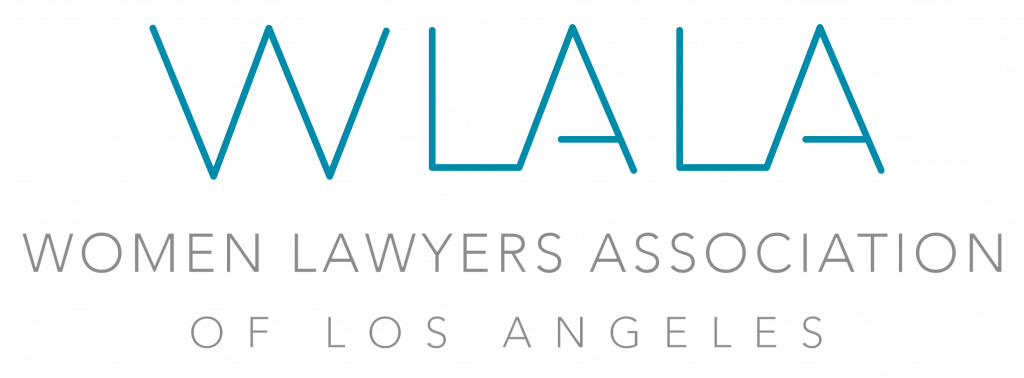IN-HOUSE COUNSEL DRIVING CHANGE
By Gicel Tomimbang and Samantha Hernandez-Ortega
July 2021
On June 10, 2021, the Business Development Committee and the In-House Counsel Committee of the Women Lawyers Association of Los Angeles (WLALA) presented “In-House Counsel Driving Change: Strategies for Promoting Diversity, Equity, and Inclusion as an In-House Attorney.” The program provided insight on topics including getting buy-in from senior management, retaining and promoting the success of diverse in-house counsel talent, allyship, and undertaking efforts, such as holding outside counsel accountable to their representations about their own diversity efforts.
Elaine Chang, Co-Chair of WLALA’s Business Development Committee, and Dawn Kennedy, Chair of the In-House Counsel Committee, introduced the event and panelists.
Jennifer Y. Ishiguro, Chief Legal Officer & Secretary of StepStone Group moderated the program. The speakers included Sharmini Green, Director & Associate General Counsel, Intel Patent Group for Intel Corporation; Margot Jackson, Managing Director, In-House Counsel Recruiting for Major, Lindsey & Africa; Stephanie A. Montaño, Regional Legal Counsel, The Americas for Control Risks; and Jeannine Taylor, Associate General Counsel for Keck Medicine of USC.
Diversity, Equity, and Inclusion Statistics Demonstrate the Need to Do More
Ms. Chang introduced the event with statistics on diversity within the legal profession. The 2020 ABA Model Diversity Survey indicates the lack of diversity within law firms does not appear to be a pipeline issue: women constitute about half of law school graduates; and people of color constitute a quarter of graduates.[1]
This tracks closely to associate levels at mid-size to large firms. According to the ABA Model Diversity Survey, in 2019, women at such firms made up approximately 45-48% of law firm associates, and people of color made up approximately 22-25% of associates. But in 2019, women at firms of all sizes made up approximately 20% of equity partners, and people of color made up between 7% -12% of equity partners. LGBTQ+ representation constituted between 1% to 2% of both associates and equity partners across mid and large size firms.
Although some law firm attorneys transition to in-house positions, a report done in conjunction with the Association of Corporate Counsel shows that women make up only 31% of the approximately 113,000 general counsel population in U.S.[2] Moreover, a survey conducted by the Minority Corporate Counsel Association (“MCCA”), found that among the largest companies, the percentage of women and people of color who were general counsel of Fortune 1000 companies in 2019 was only slightly higher than equity partner levels.[3] In 2019, 29% of Fortune 1000 general counsel were women. While the number of general counsel who are people of color at Fortune 1000 companies increased to 115 people, that is still less than 12% overall. Although the MCCA survey found gains in diversity of about 9% for both women and people of color in 2019.
MCCA’s 2020 Inclusion Survey indicates that attorneys of color in law firms and in-house are less likely to feel that they belong.[4] According to the MCCA, “[o]nce a woman or minority attorney is elevated into the general counsel position, the pool from which their successor comes from becomes more diversified as well.” Against this backdrop, it is clear that increasing diversity in more senior positions can address belonging and inclusion in corporate legal departments. In-house counsel can also take advantage of their influence over outside counsel to move the needle among the law firms they work with as well.
Successful Programs Require Support from Leadership and Employees
Ms. Ishiguro began the panel acknowledging the importance of cultivating an environment where people feel safe to have a dialogue on diversity, equity, and inclusion (“DEI”) matters and not to put the burden on diverse individuals to raise the issues and promote DEI. The panelists agreed that a successful DEI initiative requires top-down support from a company’s leadership and bottom-up engagement from employees at all levels.
Leaders must be willing to start the conversation and examine flaws in the system. The panelists acknowledged it may be challenging for leaders who are not diverse to demonstrate allyship with their diverse colleagues for fear of being perceived as overbearing or offending someone. But having someone who is not a minority demonstrate an interest in leading and investing in DEI efforts is powerful, as long as the leader is coming from a place of empathy and humility.
Ms. Taylor discussed how impactful it can be when a leader who it not a minority expresses allyship and support, encouraging others to engage and lessening the burden on diverse individuals to raise issues. Ms. Taylor shared how her CEO acknowledged during the Black Lives Matter protests that he did not have the same experiences, but he was authentic, acknowledged systemic racism and its effects on the workplace, and committed to make a change in culture. The organization conducted an anonymous employee survey that suggested that the organization could do more to ensure that people of color felt included. To address this, leadership engaged consultants to help train executives and create a forum for discussion. These actions were very powerful in helping to rebuild trust. Leaders who take an interest and are proactive have the power to shift the company’s culture and make a change.
The panelists agreed that in addition to gaining support from the leadership team, employees must also be encouraged to invest and participate in weaving diversity, equity, and inclusion into a company’s culture.
Ms. Montaño stated that leadership must adopt a clear tone and message about the company’s DEI priorities. Ms. Montaño discussed the importance of building coalitions to begin the conversation and ensure that leadership and hiring managers engage in training and recognize need for diverse candidates. In addition, since building a DEI program takes significant efforts behind the scenes to build systems, develop programs, and secure funding, it can be awhile before any impact is felt. Ms. Montaño encouraged people to look for way to engage employees throughout the process. For example, Ms. Montaño’s DEI Committee launched relevant book and film discussion groups and held fireside chats lead by more senior employees who have volunteered to take an active role in engaging with others and be open and vulnerable.
Ms. Green agreed, stating that although Intel has a Diversity & Inclusion Officer, they also rely on approximately 100 volunteers worldwide. At Intel, many smaller group discussions are led by senior leaders regardless of whether they are diverse, which encourages other people to share. Ms. Green discussed how her company set a goal to achieve equal representation for women by 2020. Through the joint efforts of leadership, recruiting, and employees, the company achieved its goals in 2018, two years ahead of schedule. Ms. Green advised that part of the program’s success came from setting milestones to celebrate small wins. This helped everyone to stay motivated while working to achieve larger diversity, equity, and inclusion goals.
Ms. Jackson added that company leaders, whether or not they are from diverse backgrounds, should feel empowered to address issues impacting DEI candidly. Moreover, having a platform gives leaders the responsibility to acknowledge important issues. For example, Ms. Jackson appreciated that company’s president used his weekly business update emails to immediately express support for social justice issues like Black Lives Matter and the Stop Asian Hate movement. Having someone, particularly a white male leader, take the mantle to advocate for these issues helped employees feel seen and heard, and encouraged the concept of being able to bring your whole self to work.
Furthermore, when leaders have the courage to be open and vulnerable, it can not only be seen as a strength, but can build trust and encourage others. The panelists agreed that employees today are interested in bringing their whole self to work, and that fostering a culture of diversity, equity, and inclusion in the workplace helps to encourage employees to share more of their identity.
The Business Case for Promoting Diversity, Equity, and Inclusion
Ms. Jackson advised that meaningful investments in diversity, equity, and inclusion helps to attract and retain top talent, particularly in this candidate’s market. As a recruiter for in-house counsel positions, top candidates (and particularly millennial candidates) are looking for meaningful diversity and inclusion in their workplace culture. Candidates are asking more questions about a company’s diversity, equity, and inclusion initiatives than before. They are also looking more closely at the diversity of a company’s leadership, the interviewers, and their legal teams. Employees who feel their diversity, equity, and inclusion values or concerns have not been heard might decide to look elsewhere.
Ms. Jackson explained that Major, Lindsey & Africa educates clients to achieve a better culture because it is both morally better and makes business sense to attract and retain top talent. When a company culture demonstrates that DEI is an important value from top-down, it is much easier for employees to speak up. Otherwise, employees may perceive a penalty for speaking up or fear retaliation. Ms. Jackson has seen some candidates look elsewhere when they felt their concerns were not heard or that they could not articulate their concerns without fear of consequences. These companies are at a significant competitive disadvantage.
Ms. Taylor advised that focusing on the business case can assist with getting the attention of executives who may be less swayed by social justice arguments. In addition to strengthening company culture and helping to attract and retain top talent, DEI programs may help a company with marketing initiatives or appeal to certain customer groups. Ms. Montaño also noted the liability and employment risk if diverse employees don’t feel supported or trust their employer. Ms. Montaño suggested introducing DEI initiatives to executives as you would approach a customer pitch, and determine ahead of time what arguments will persuade leaders.
Promoting Diversity, Equity, and Inclusion With Outside Counsel and Vendors
Failure to have diverse leadership can be a marketing and public relations risk as well. Ms. Ishiguro provided an example of an Am Law 200 law firm that was heavily criticized after publishing an announcement for its new partners, and the photos showed only white males. Ms. Ishiguro also shared that after she saw a Midwest financial services firm advertise a CLE program where all five panelists were white males, she called the chairman of the firm to criticize the decision.
The panelists agreed that in-house counsel should also exert influence over outside counsel or vendors. Although you may not always be able to pick the law firm you work with due to longstanding relationships with a law firm relationship partners who is often not diverse, you can pick the partners you would like to work with and go to them directly. Hiring diverse partners to lead teams usually results in more diverse teams. You can also require diverse staffing on your matters.
Ms. Taylor noted that if a lack of diversity, equity, and inclusion at a firm is a factor in choosing not to retain a firm’s services, relaying that can be a powerful driver for change at the law firm. If enough clients ask their outside counsel about diversity, firms will have to make changes.
Ms. Green shared that her company came up with the Intel rule, and gave their outside counsel about one year to meet minimum diversity requirements across the firm. Even though the firms resisted and said it couldn’t be done in that timeframe, each firm ultimately met the minimum diversity requirements in order to keep Intel’s business.
Ms. Ishiguro reminded the audience that the relationship with outside counsel is a journey. You can start with having a diverse partner or team staffed on your matters, and if your company has sufficient business, try to push for greater diversity at the firm or local office.
Being an Ally and Encouraging Others to Become Allies
The panelists agreed that diversity, equity, and inclusion initiatives are most effective when all communities within a company are engaged. Diversity programs with a comprehensive inclusion plan invites and encourages input from people with different views, broadens the conversation, and paves the way for developing allyship.
Moreover, company leaders and employees should not assume that diversity, equity, and inclusion initiatives do not apply to them if they do not fit certain diversity categories, and should feel empowered to participate alongside their diverse colleagues. Similarly, diverse leaders and employees should not assume that their colleagues are not interested in learning about and supporting diversity, equity, and inclusion initiatives just because they are not of a certain background.
Ms. Green added that no matter how good your programs are, you are missing the critical inclusion piece if you don’t engage people with different views and backgrounds in the conversation. For example, Intel has inclusive leadership training and a male ally program and encourages male leaders to attend conferences such as the Better Man Conference. Ms. Green suggested a simple way you can support your diverse colleagues is by speaking up when you witness a potential microaggression. For example, if you are in a meeting and a colleague is interrupted or not acknowledged, you could acknowledge them by saying, “thank you for your input, but I think our colleague also had something to contribute . . .” or “that is a great point, and as my colleague mentioned earlier . . .” to make sure your colleague is heard.
Ms. Jackson noted that diversity, equity, and inclusion is a journey that is not achieved overnight, and, therefore, each of us has a role to play in improving these initiatives in the professional spaces we occupy. We need to invest in educating ourselves so that we understand the obstacles that hampers the advancement of diversity, equity, and inclusion. We should also encourage our leaders and colleagues, regardless of their backgrounds, to do the same because achieving diversity, equity, and inclusion is a team effort.
Ms. Ishiguro admitted that speaking up can be hard even when you are in senior leadership, and that an environment where all employees are encouraged to speak up can give courage to leaders as well. Even though Ms. Ishiguro knew her company was supportive of DEI and made a statement supporting Black Lives Matter, she hesitated to be the one to say something as attacks against Asian Americans gained awareness. As the most senior Asian American employee at the company and the newest executive on the team, she was initially concerned about being the one to raise the issue. What pushed her to take action was seeing her Asian American assistant looking very upset one day and asking her what was wrong. The employee stated that she was very upset about the shootings in Atlanta and that she herself had experienced hate incidents recently. Ms. Ishiguro realized that she had a responsibility to use her position to inform the executive team of how employees were being affected, and that the company needed to acknowledge it. Ms. Ishiguro thanked her assistant for giving her the courage to raise her voice.
Ms. Montaño advised that if you are working for a company where diversity, equity, and inclusion is lacking, you should feel empowered to advocate that the company to prioritize those issues. She recommended starting this journey by engaging others in your company in relevant meaningful conversations so that you can start building a coalition to support these goals and push for change.
Ms. Montaño also noted the importance of not making assumptions about people because of their backgrounds. In one of their small group discussions, a white male senior leader shared his own vulnerability because people often attributed viewpoints based on his appearance and living in the South. He shared his struggles with wanting to interrupt conversations where he wanted to speak up. The company hosted a fireside chat with the CEO to address being an ally and standing up against hate issues.
The panelists agreed that it is best to assume positive intent first, and that that someone who misspoke made an unintentional or uninformed statement. Ms. Jackson noted that sometimes biases can be so deeply ingrained that an individual wouldn’t recognize a problem unless it gets questioned in a kind way. Ms. Montaño agreed, stating that being too judgmental can result in stonewalling or arguments that is not productive. Instead of being argumentative, simply asking questions about why someone came to a specific conclusion can challenge problematic assumptions or conversations and gives that person an opportunity to save face or not feel attacked. Ms. Taylor noted that people should not feel scared to speak up for fear of being seen as a white knight, and by calling out an issue in these ways can give support to diverse colleagues who may be offended without being overbearing.
Ms. Ishiguro shared how bystander training teaches different ways to show support, depending on the circumstances and your own comfort level. Sometimes jumping in immediately is helpful, but other times it is better not to address the issue overtly, and show subtle support at the time or discussing with the individual afterward. Ms. Ishiguro noted that everyone has implicit biases, so it is important to turn the mirror on ourselves. Giving people a chance to explain themselves helps make the workplace a safe place for everyone so that everyone can bring their whole selves to work.
Overall, the event was a success sharing effective strategies for in-house counsel to promote diversity, equity, and inclusion in their workplace and with outside counsel.
Thank you again to our speakers and sponsors Driven, Sheppard Mullin, JAMS, Vedder Price, Patterson + Sheridan, and Sanders Robert. Congratulations to Carolyn Domen-Broshears for winning the raffle sponsored by Driven.


